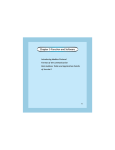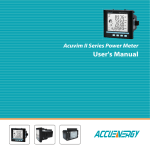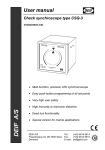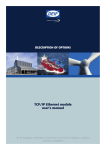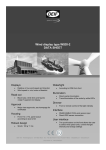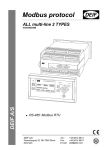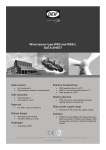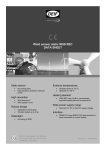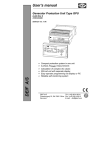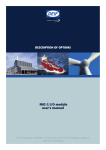Download Mic-2 profibus module user's manual
Transcript
Description of options MIC-2 Profibus module user’s manual DEIF A/S · Frisenborgvej 33 · DK-7800 Skive · Tel.: +45 9614 9614 · Fax: +45 9614 9615 · [email protected] · www.deif.com Document no.: 4189320031A Legal information and warnings MIC-2 This manual may not be altered or reproduced in whole or in part by any means, without expressed written permission of DEIF. The information contained in this document is believed to be accurate at the time of publication, however, DEIF assumes no responsibility for any errors which may appear here and reserves the right to make changes without notice. Please ask your local representative for the latest product specifications before ordering. Please read this manual carefully before installation, operation and maintenance of the MIC-2 multi-instrument. The following symbols are used in this user’s manual and on the MIC-2 multi-instrument: High voltage symbol. Electrical hazard voltage can cause shock, burns or person injury or death. Failure to observe the information may result in injury or death. Danger symbol. Observe the information after the symbol to avoid possible injury or death. Installation and maintenance of the MIC-2 multi-instrument should only be performed by qualified, competent personnel trained and experienced in working with high voltages and currents. This document is not fit for any untrained people. DEIF is not responsible or liable for any damages cause by improper installation and/or operation. www.deif.com Content MIC-2 Starting . . . . . . . . . . . . . . . . . . . . . . . . . . . . . . . . . . . . . . . . . . . . . . . . . . . . . . . . . . . . . . . . . . . . . . . . . . . . . . . . . . . . . . . . . . . . . . . . . . . . . . . . . . . . . . . . . . . . . . . . . . . . . . . . . . . . . . . . . . . . . . . . . . . . . . . . . . . . . . . . . . . . . . . . . . . . . . . . . . . . . . . . . . . . . . . . . . . . . . . . 4 Chapter 1 Introduction 1.1 Introduction of Profibus Technology . . . . . . . . . . . . . . . . . . . . . . . . . . . . . . . . . . . . . . . . . . . . . . . . . . . . . . . . . . . . . . . . . . . . . . . . . . . . . . . . . . . . . . . . . . . . . . . . . . . . . . . . . . . . . . . . . . . . . . . . . . . . . . . . . . . . . . . . . . . . . . . . . . . . . . . . . . . 5 2.2 Application points of Profibus module . . . . . . . . . . . . . . . . . . . . . . . . . . . . . . . . . . . . . . . . . . . . . . . . . . . . . . . . . . . . . . . . . . . . . . . . . . . . . . . . . . . . . . . . . . . . . . . . . . . . . . . . . . . . . . . . . . . . . . . . . . . . . . . . . . . . . . . . . . . . . . . . . . . . . . . . 6 Chapter 2 Wiring and hardware configuration 2.1 Appearance and Dimensions . . . . . . . . . . . . . . . . . . . . . . . . . . . . . . . . . . . . . . . . . . . . . . . . . . . . . . . . . . . . . . . . . . . . . . . . . . . . . . . . . . . . . . . . . . . . . . . . . . . . . . . . . . . . . . . . . . . . . . . . . . . . . . . . . . . . . . . . . . . . . . . . . . . . . . . . . . . . . . . . . . . . 7 2.2 Installation Method . . . . . . . . . . . . . . . . . . . . . . . . . . . . . . . . . . . . . . . . . . . . . . . . . . . . . . . . . . . . . . . . . . . . . . . . . . . . . . . . . . . . . . . . . . . . . . . . . . . . . . . . . . . . . . . . . . . . . . . . . . . . . . . . . . . . . . . . . . . . . . . . . . . . . . . . . . . . . . . . . . . . . . . . . . . . . . . . . . 8 2.3 Definition of DP Interface . . . . . . . . . . . . . . . . . . . . . . . . . . . . . . . . . . . . . . . . . . . . . . . . . . . . . . . . . . . . . . . . . . . . . . . . . . . . . . . . . . . . . . . . . . . . . . . . . . . . . . . . . . . . . . . . . . . . . . . . . . . . . . . . . . . . . . . . . . . . . . . . . . . . . . . . . . . . . . . . . . . . . . . . . 9 2.4 Bus Terminal . . . . . . . . . . . . . . . . . . . . . . . . . . . . . . . . . . . . . . . . . . . . . . . . . . . . . . . . . . . . . . . . . . . . . . . . . . . . . . . . . . . . . . . . . . . . . . . . . . . . . . . . . . . . . . . . . . . . . . . . . . . . . . . . . . . . . . . . . . . . . . . . . . . . . . . . . . . . . . . . . . . . . . . . . . . . . . . . . . . . . . . . 10 Chapter 3 Application of Profibus DP Protocol 3.1 Address Setting . . . . . . . . . . . . . . . . . . . . . . . . . . . . . . . . . . . . . . . . . . . . . . . . . . . . . . . . . . . . . . . . . . . . . . . . . . . . . . . . . . . . . . . . . . . . . . . . . . . . . . . . . . . . . . . . . . . . . . . . . . . . . . . . . . . . . . . . . . . . . . . . . . . . . . . . . . . . . . . . . . . . . . . . . . . . . . . . . . . . . 11 3.2Baud Rate . . . . . . . . . . . . . . . . . . . . . . . . . . . . . . . . . . . . . . . . . . . . . . . . . . . . . . . . . . . . . . . . . . . . . . . . . . . . . . . . . . . . . . . . . . . . . . . . . . . . . . . . . . . . . . . . . . . . . . . . . . . . . . . . . . . . . . . . . . . . . . . . . . . . . . . . . . . . . . . . . . . . . . . . . . . . . . . . . . . . . . . . . . . . . 12 3.3 GSD Files . . . . . . . . . . . . . . . . . . . . . . . . . . . . . . . . . . . . . . . . . . . . . . . . . . . . . . . . . . . . . . . . . . . . . . . . . . . . . . . . . . . . . . . . . . . . . . . . . . . . . . . . . . . . . . . . . . . . . . . . . . . . . . . . . . . . . . . . . . . . . . . . . . . . . . . . . . . . . . . . . . . . . . . . . . . . . . . . . . . . . . . . . . . . . 13 3.4 Information Exchange . . . . . . . . . . . . . . . . . . . . . . . . . . . . . . . . . . . . . . . . . . . . . . . . . . . . . . . . . . . . . . . . . . . . . . . . . . . . . . . . . . . . . . . . . . . . . . . . . . . . . . . . . . . . . . . . . . . . . . . . . . . . . . . . . . . . . . . . . . . . . . . . . . . . . . . . . . . . . . . . . . . . . . . . . . . . 14 3.5 Format of function code 01H . . . . . . . . . . . . . . . . . . . . . . . . . . . . . . . . . . . . . . . . . . . . . . . . . . . . . . . . . . . . . . . . . . . . . . . . . . . . . . . . . . . . . . . . . . . . . . . . . . . . . . . . . . . . . . . . . . . . . . . . . . . . . . . . . . . . . . . . . . . . . . . . . . . . . . . . . . . . . . . . . 15 3.6 Format of function code 05H . . . . . . . . . . . . . . . . . . . . . . . . . . . . . . . . . . . . . . . . . . . . . . . . . . . . . . . . . . . . . . . . . . . . . . . . . . . . . . . . . . . . . . . . . . . . . . . . . . . . . . . . . . . . . . . . . . . . . . . . . . . . . . . . . . . . . . . . . . . . . . . . . . . . . . . . . . . . . . . . . 16 3.7 Format of function code 02H . . . . . . . . . . . . . . . . . . . . . . . . . . . . . . . . . . . . . . . . . . . . . . . . . . . . . . . . . . . . . . . . . . . . . . . . . . . . . . . . . . . . . . . . . . . . . . . . . . . . . . . . . . . . . . . . . . . . . . . . . . . . . . . . . . . . . . . . . . . . . . . . . . . . . . . . . . . . . . . . . . 17 3.8 Format of function code 03H . . . . . . . . . . . . . . . . . . . . . . . . . . . . . . . . . . . . . . . . . . . . . . . . . . . . . . . . . . . . . . . . . . . . . . . . . . . . . . . . . . . . . . . . . . . . . . . . . . . . . . . . . . . . . . . . . . . . . . . . . . . . . . . . . . . . . . . . . . . . . . . . . . . . . . . . . . . . . . . . . . 18 3.9 Format of function code 10H . . . . . . . . . . . . . . . . . . . . . . . . . . . . . . . . . . . . . . . . . . . . . . . . . . . . . . . . . . . . . . . . . . . . . . . . . . . . . . . . . . . . . . . . . . . . . . . . . . . . . . . . . . . . . . . . . . . . . . . . . . . . . . . . . . . . . . . . . . . . . . . . . . . . . . . . . . . . . . . . . . 19 www.deif.com Starting MIC-2 This manual describes the Profibus module for the MIC-2. With the Profibus module, the MIC-2 can be linked to a Profibus network easily, and it can realise distribution automation based on field bus. Please read this manual carefully before operating or setting the MIC-2 meter to avoid unnecessary trouble. Chapter 1 helps you to understand the basic concept of Profibus, and the application points of the Profibus module. Chapter 2 describes hardware features of the Profibus module in detail. Chapter 3 describes software application of the Profibus module in detail. www.deif.com 1.1 Introduction of Profibus Technology MIC-2 The Profibus module is an extended communication module of the MIC-2. With the Profibus module, the MIC-2 can be linked to a Profibus network easily. 1.1 Introduction of Profibus technology Profibus (Process field bus) is an international field bus standard which is widely used in automation technology. It is a widely used, open digital communication system, which is suitable for high-speed, time-critical, and high reliability communications. Profibus is an open style field bus standard promoted by the Siemens Corporation. In 1989, it became the German standard DIN19245, in 1996 the European standard EN50170, in December 1999 it was accepted as a part of the international standard IEC61158, in 2001 it became the China national standard JB/T 10308.3-2001 for field bus of machinery industry controlling systems. Profibus has provided 3 kinds of agreements types: Profibus-DP (Decentralized Periphery), Profibus-PA Process Automation) and Profibus-FMS (Field bus Message Specification). They all follow the same protocol. With optimised, high-speed, low-cost communications links, Profibus-DP is especially used in automatic controlling systems and equipment-level decentralised I/O communication, it can meet real-time response, stability and reliability of equipment level and distributed controlling systems. The Profibus module uses the Profibus-DP (V0) protocol. www.deif.com 1.2 Application points of the Profibus module MIC-2 Please read the appendix of technical data and specifications of the Profibus module before using it. In addition, please read the MIC-2 manual, especially the communication addresses of Modbus protocol, which are the communication addresses for Profibus module too. • The Profibus module can only be used as slave in a Profibus network. Its slave address is ranged from 0 to 126, which can only be set by means of the panel. If the address is changed, it will take effect immediately. • The Profibus module’s baud rate can be adaptive between 9.6Kbps to 12Mbps in a Profibus network. • The Profibus module’s hardware connection method should be accurately known, otherwise debugging and usage and debugging will be difficult. • Please read the GSD file of the Profibus module carefully before using it. It contains much technology information such as device name, ID number and so on. • Please read and understand the communication data format, which is the key point of the Profibus module. • The simple example of PLC as a master will be useful if you want to understand the application characteristics of the Profibus module. www.deif.com 2.1 Appearance and dimensions MIC-2 Profibus module must be linked to MIC-2 meter when it is to be used. In addition, Profibus module must be the first extended module linked to MIC-2 meter. 90mm Note The environment temperature and humidity is to meet the MIC-2 requirements. Otherwise, the MIC-2 may be damaged. 55.6mm (Top View) (Bottom view) 22 mm (Side view) www.deif.com 2.2 Installation method MIC-2 Environment Please check the environment temperature and humidity to ensure they fall within the MIC-2 and optional modules requirement before installing the unit. Temperature Operation: -25°C to 70°C Storage: -40°C to 85°C Humidity 5% to 95% non-condensing. Position The MIC-2 and modules should be installed in a dry and dust-free environment. Avoid heat, radiation and high electrical noise sources. Installation method With the link pins, optional modules are linked to the MIC-2 and each other. The maximum number of extended modules linked to MIC-2, including I/O module, Ethernet module and PROFIBUS module, is three. The communication modules must be installed first. No other module can be installed before them. Disconnect your MIC-2 from any live voltages and currents before following the below instructions! 1. Remove the Ext. Port protection lid. 1. Insert the installation clips in the counterpart of MIC-2, and then press the module gently, so linking is established. Handle the installation with care to avoid damage to the optional module and/or the MIC-2 unit. 2. Tighten the installation screw. 3. Install other modules in the same way. Figure 2-2 Installation of optional modules www.deif.com 2.3 Definition of DP interface MIC-2 The Profibus module uses a standard D-type connector. The mechanical and electrical characteristics of the connector comply with the requirements of IEC 807-3. The connector pins are distributed as follows: Pins RS-485 ID Content 1 —— SHIELD Power GND 2 —— N24V -24V Output 3 B RXD/TXD-P Data P (Receive /Send) 4 —— CNTR-P Controlling P 5 C DGND Digital Ground 6 —— Vp Positive Voltage 7 —— P24V +24V output 8 A RXD/TXD-N Data N (Receive /Send) 9 —— CNTR-N Controlling N www.deif.com 2.4 Bus terminal MIC-2 Based on DP standard, the first station and the last station in Profibus-DP network should connect bus terminal (resistor), and it is not necessary for other stations, as shown in below figure. STATION 3 P N STATION 4 P N Vp Vp 390 390 220 220 P P STATION 1 STATION 2 N N 390 DGND 390 DGND Connection of many DP stations The bus terminal is composed of three resistors and connection wire, where Vp is the supply positive voltage and DGND is the Digital Ground. When the bus is idle, the bus terminal makes the data P level higher than data N, so the bus’s idle signal is always 1. 10 www.deif.com 3.1 Address setting MIC-2 The Profibus module can only be used as slave in a Profibus network. Its slave address is ranged from 0 to 126, which can only be set by the panel (in SYS sub menu of the MIC-2 setting menu). If the address is changed, it will take effect immediately. The below figure shows the address setting of Profibus module. Address setting of the Profibus module 11 www.deif.com 3.2 Baud rate MIC-2 The Profibus module works in Profibus networks with a baud rate between 9.6Kbps and 12Mbps. 12 www.deif.com 3.3 GSD file MIC-2 A Profibus-DP master can exchange data with various slave stations. In order to identify various slave stations safely and conveniently, it is necessary to obtain the technical data of slave stations. The file where the technical data is described is called Generic Station Description File (GSD). Because of the importance of the GSD file, please read it carefully before using the Profibus module. The GSD file is provided in pure text format with detailed comments. • As a DP slave station, the Profibus module supports protocol of V0. • The Profibus module’s data interface is a 16 words input/output interface. • The slave address of Profibus module can be set using the panel. If the address is changed, it will take effect immediately, restarting your MIC-2 will not be necessary. • The GSD file is available for software download on www.deif.com under “Download centre” > “Software download”. 13 www.deif.com 3.4 Information exchange MIC-2 A variety of information can be transmitted to/from the MIC-2 by the Profibus module, such as electrical quantities and other parameters. The basic communication method of the MIC-2 is RS-485, which uses protocol of Modbus-RTU. In order to use the same address lists as Modbus-RTU, the communication formats of Profibus-DP are categorised in the same way as Modbus-RTU. We recommend reading chapter 5 (communication) of the MIC-2 user’s manual before you proceed. Among other things, the chapter contains a Modbus-RTU address lists pointing the below out: 1. There are various function codes, such as 01H, 02H,03H, 05H,10H, for the various categorised parameters. Different function codes have different formats of query and response frames. 2. There is a specific relationship between the numerical value in register of the MIC-2 and the real physical value. 3. Different parameters may have different data length and data type. These three points are also suitable for the Profibus-DP protocol in the Profibus module. Note: the following “communication formats” are suitable for the application data, but not for the Profibus-DP’s frame characteristic data. Function codes, such as 01H, 02H and 03H, are inquiry commands. For users to quickly switch the inquiry contents, we define 8 channels named 1 to 8, in order to update data more quickly. 14 www.deif.com 3.5 Format of function code 01H MIC-2 Function code 01H is used to read the relay status in Modbus-RTU. In Profibus-DP, the format of function code 01H is defined as follows: Query: Frame Bytes Caption Byte1 Channels can be chosen from 1 to 8 Byte2 01H Byte3 Starting address high byte Byte4 Starting address low byte Byte5 Quantity of coils high byte Byte6 Quantity of coils low byte Byte7~32 0 Because 16 words are required for I/O data in GSD file, all other bytes after Byte7 are set to 0. Response It is the information that slave stations response to master. Frame Bytes Caption Byte1 The channel of inquiry frame Byte2 01H Byte3 Byte count Byte4 Coil status Byte5~32 0 The coils in the response message are packed as one coil per bit of the data field. Status is indicated as 1=ON and 0=OFF. The LSB of the first data byte contains the output addressed in the query. The other coils follow toward the high order end of this byte, and form low order to high order in subsequent bytes. Example: reading Relay1 and Relay2 states (start register address is 0000H). Use 4 channels. Query Byte1 04H Byte2 01H Byte3 00H Byte4 00H Byte5 00H Byte6 02H Byte7~32 00H Response Byte1 04H Byte2 Byte3 Byte4 Byte5 Byte6 Byte7~32 01H 01H 02H 00H 00H 00H 7 6 5 4 3 2 1 0 0 0 0 0 0 0 1 0 Coil Status MSB LSB ( Relay 1 = OFF, Relay 2=ON ) 15 www.deif.com 3.6 Format of function code 05H MIC-2 The message with function code (05H) in Modbus-RTU forces a single relay either on or off. The data value FFOOH will set the relay on and the value 0000H will turn it off. All other values are illegal and will not affect that relay. In Profibus-DP, the format of function code 05H is defined as follows: Query Frame Bytes Caption Byte1 FAH Byte2 05H Byte3 Outputs address high byte Byte4 Outputs address low byte Byte5 Outputs value high byte Byte6 Outputs value low byte Byte7~32 0 Note: Since Profibus-DP V0 exchanges information data periodically, controlling information such as function code 05H should be used carefully. Response The normal response to the command request is to retransmit the message as received after the relay states has been altered. Frame Bytes Caption Byte1 FAH Byte2 05H Byte3 Outputs address high byte Byte4 Outputs address low byte Byte5 Outputs value high byte Byte6 Outputs value low byte Byte7~32 0 Example: setting Relay2 on. Query Byte1 Byte2 Byte3 Byte4 Byte5 Byte6 Byte7~32 FAH 05H 00H 01H FFH 00H 00H Byte1 Byte2 Byte3 Byte4 Byte5 Byte6 Byte7~32 FAH 05H 00H 01H FFH 00H 00H Response 16 www.deif.com 3.7 Format of function code 02H MIC-2 Function code 02H is used to read DI status in Modbus-RTU. In Profibus-DP, the format of function code 02H is defined as follows: Query Frame Bytes Caption Byte1 Channels can be chosen from 1 to 8 Byte2 02H Byte3 Starting address high byte Byte4 Starting address low byte Byte5 Quantity of digital inputs high byte Byte6 Quantity of digital inputs low byte Byte7~32 0 Response Frame Bytes Caption Byte1 The channel of inquiry frame Byte2 02H Byte3 Byte count Byte4 Inputs status1 Byte5 Inputs status2 (or 0) Byte6 Inputs status3 (or 0) Byte7 Inputs status4 (or 0) Byte8~32 0 The digital inputs in the response message are packed as one input per bit of the data field. Status is indicated as 1=ON; 0=OFF. The LSB of the first data byte contains the input addressed in the query. The other inputs follow toward the high order end of this byte, and from low order to high order in subsequent bytes. Example: reading 4 DI statuses (starting address is 0000H). Use 6 channels. Query Byte1 06H Byte2 02H Byte3 00H Byte4 00H Byte5 00H Byte6 Byte7~32 04H 00H Response Byte1 06H Byte2 Byte3 Byte4 Byte5~32 02H 01H 06H 00H 7 6 5 4 3 2 1 0 0 0 0 0 0 1 1 0 DI status MSB LSB ( DI1 = OFF, DI2=ON, DI3 = ON , DI4 = OFF ) 17 www.deif.com 3.8 Format of function code 03H MIC-2 This function code is used in Modbus-RTU to read the contents of a contiguous block of holding registers in the MIC-2. In Profibus-DP, the format of function code 03H is defined as follows: Query Frame Bytes Caption Byte1 Channels can be chosen from 1 to 8 Byte2 03H Byte3 Starting address high byte Byte4 Starting address low byte Byte5 Quantity of registers high byte Byte6 Quantity of registers low byte Byte7~32 0 “Quantity of registers” shows how many words will be read. Response Frame Bytes Caption Byte1 The channel of inquiry frame Byte2 03H Byte3 Byte count Byte4 Register value1 high byte Byte5 Register value1 low byte Byte6 … Byte32 … “Byte count” shows how many bytes will be read. The register data in the response message are packed as two bytes per register, with the binary contents right justified with each byte. For each register, the first byte contains the high order bits and the second contains the low order bits. There is one important thing which should be noted. The response frame contains 16 words, so the maximum “quantity of registers” should be less than 15. Otherwise, it will return an error result. Example: reading 3 measured data (F,V1,V2) from the MIC-2 meter. The data address of F includes 4000H and 4001H. The data address of V1 includes 4002H and 4003H. The data address of V2 includes 4004H and 4005H. (Use 7 channels) Query Byte1 Byte2 Byte3 Byte4 Byte5 Byte6 Byte7~32 07H 03H 40H 00H 00H 06H 00H Byte1 Byte2 Byte3 Byte4 Byte5 Byte6 Byte7 Byte8 07H 03H 0CH 42H 48H 00H 00H 42H Byte9 Byte10 Byte11 Byte12 Byte13 Byte14 Byte15 Byten16~32 C7H CCH CDH 42H C8H 33H 33H 00H Response (F=42480000H(50.00Hz), V1=42C7CCCDH(99.9v), V2=42C83333H(100.1v)). Note: Please refer to the communication chapter of the MIC-2 user’s manual for a detailed description of the relationship between the numerical value in the register of the MIC-2 and the real physical value. 18 www.deif.com 3.9 Format of function code 10H MIC-2 This function code is used in Modbus-RTU to write a block of contiguous registers in the MIC-2, for instance system parameter settings. In Profibus-DP, the format of function code 10H is defined as follows: Query Frame Bytes Caption Byte1 FAH Byte2 10H Byte3 Starting address high byte Byte4 Starting address low byte Byte5 Quantity of registers high byte Byte6 Quantity of registers low byte Byte7 Byte count Byte8 Register value 1 high byte Byte9 Register value 1 low byte Byte10 Register value 2 high byte Byte11 Register value 2 low byte … … Byte32 0 “Quantity of registers” shows how many words will be written. “Byte count” shows how many bytes will be written. If “quantity of register” is N, then “byte count” is (N×2). There is one important thing should be noted. The response frame contains 16 words, so the maximum “quantity of registers” should be less than 13. Otherwise, it will return an error result. Response The normal response returns the function code, starting address, and quantity of registers written. Frame Bytes Caption Byte1 FAH Byte2 10H Byte3 Starting address high byte Byte4 Starting address low byte Byte5 Quantity of registers high byte Byte6 Quantity of registers low byte Byte7~32 0 Example: presetting import active enengy (EP_imp) to 17807783.3Kwh. Based on the relationship between the register value and the physical value, we can conclude that the register value in hex is 0A9D4089H. The data address of EP_imp includes 4048H and 4049H. Query Byte1 Byte2 Byte3 Byte4 Byte5 Byte6 Byte7 Byte8 Byte9 Byte10 Byte11 Byte12~32 FAH 10H 40H 48H 00H 02H 04H 0AH 9DH 40H 89H 00H Byte1 Byte2 Byte3 Byte4 Byte5 Byte6 Byte7~32 FAH 10H 40H 48H 00H 02H 00H Response 19 www.deif.com



















